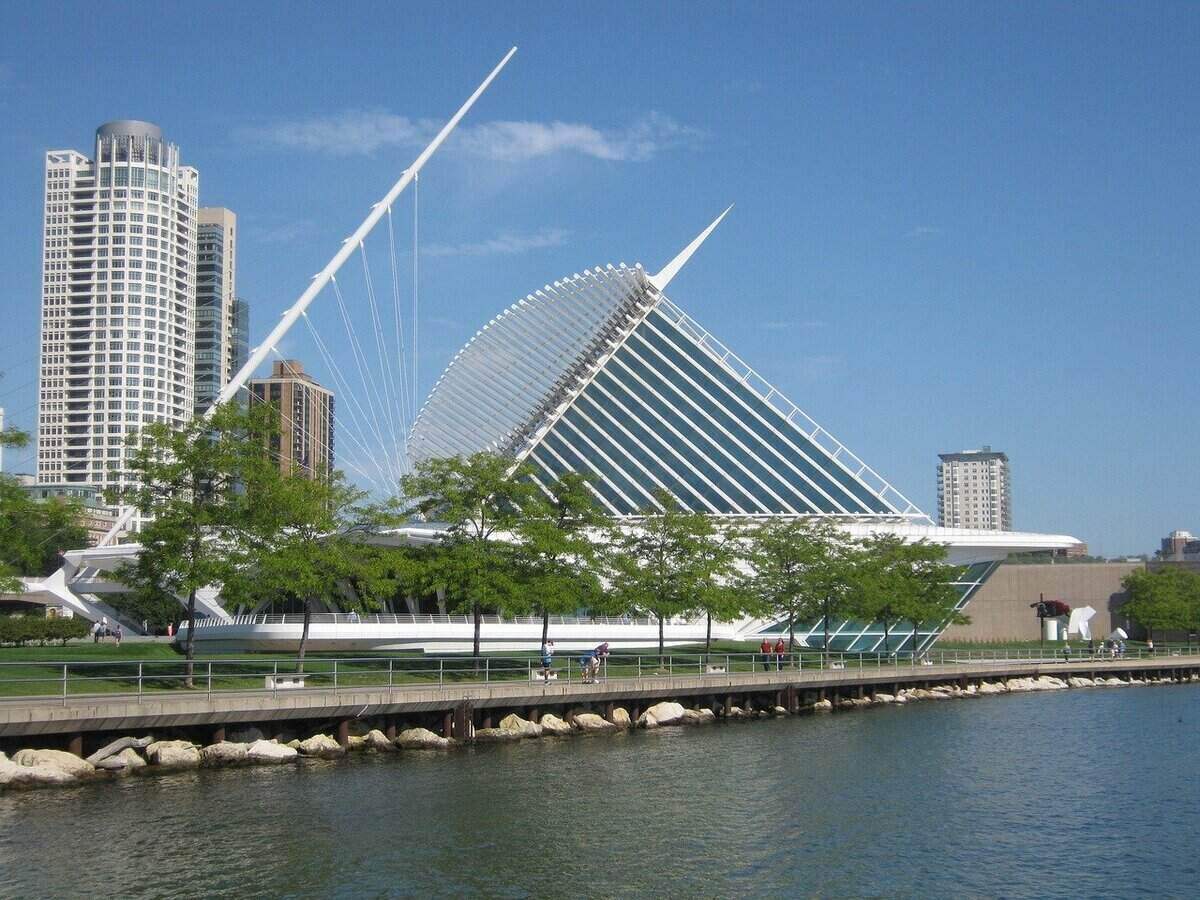
Being in the Great Lakes Region, Milwaukee has four distinct seasons, with the extremes being very cold winters and warm, humid summers. These four grass types will thrive in Milwaukee with little work:
- Kentucky bluegrass
- Perennial ryegrass
- Fine fescues
- Turf-type tall fescue
1. Kentucky bluegrass
Kentucky bluegrass is known for its dark green color, blue-tipped seedheads, rounded blades, and dense carpet. This makes it the most popular choice for lawns across Milwaukee.
- Classification: Cool-season grass
- Spreads by: Underground stems, or rhizomes
- Shade tolerance: Kentucky bluegrass has a low shade tolerance, preferring full sun.
- Drought tolerance: Goes dormant in drought conditions, but bounces back with watering.
- Foot traffic tolerance: Thanks to its fast-growing rhizomes, Kentucky bluegrass can hold up well under heavy foot traffic.
- Maintenance needs: Fertilize in spring and early fall using a slow-release formula. Proper watering (about 1 to 2 inches per week) is necessary to maintain Kentucky bluegrass’s color. Watch out for thatch buildup, which can lead to disease and pests problems.
- Recommended mowing height: 2.5-3 inches
2. Perennial ryegrass
Recommended by the University of Wisconsin Extension, perennial ryegrass boasts broad blades, a wet shine, and dark green color. This turf works best if you mix it with other grasses such as Kentucky bluegrass.
- Classification: Cool-season grass
- Spreads by: Vertical shoots called “tillers”
- Shade tolerance: Perennial ryegrass can survive in shaded areas for years.
- Drought tolerance: Perennial ryegrass does not do well with drought and will need supplemental irrigation.
- Foot traffic tolerance: Holds up well to traffic from kids and pets.
- Maintenance needs: Mixing it with other grass types provides perennial ryegrass protection from disease, weeds, and pests. When rainfall is scarce, frequent watering is necessary to maintain perennial ryegrass’s dark green hue.
- Recommended mowing height: 1.5-2.5 inches
3. Fine fescues
Fine fescues come in a variety of types, including creeping red, chewings, and hard fescue — the ones that grow best in our climate zone. Fescues are known for their fine-textured leaves that stay green all year long, with proper care.
- Classification: Cool-season grass
- Spreads by: Rhizomes
- Shade tolerance: Notably hardy, these grasses flourish in all sorts of environments, including shaded ones.
- Drought tolerance: Fine fescues stand up well to drought conditions.
- Foot traffic tolerance: Poor
- Maintenance needs: Low. Fine fescues don’t need much water, and since these grasses can thrive in poor-nutrient soil, constant fertilization isn’t necessary.
- Recommended mowing height: 1.5-3 inches
4. Turf-type tall fescue
Tall fescue, recognized by its coarse texture and light green color, is commonly used in lawns across the country, including here in Milwaukee.
- Classification: Cool-season grass
- Spreads by: Unlike the bunch-growing style of standard tall fescue, this turf type can spread via rhizomes.
- Shade tolerance: This variety can grow well in partial shade and full sun.
- Drought tolerance: Because of its deep roots, turf-type tall fescue can withstand short periods of drought. Longer dry periods require supplemental irrigation.
- Foot traffic tolerance: Heavy foot traffic is no trouble for tall fescue.
- Maintenance needs: A low-maintenance option, turf-type tall fescue needs little water and can be fertilized just once per year in the fall.
- Recommended mowing height: With its high growth rate, this type will need mowing every five to six days at a height of 2-4 inches.
How to select the best grass type for your Milwaukee lawn
Before you decide which of these best grass types is perfect for your lawn, you’ll need to answer a few questions about your yard:
Fine fescue and turf-type tall fescue are ideal for yards that receive both sun and shade.
Out of all the best grasses for Milwaukee, fine fescue does best in drought conditions.
If want a low-maintenance turf, choose fine fescue or turf-type tall fescue. If you don’t mind hiring someone maintain your lawn, then go with Kentucky bluegrass or perennial ryegrass.
If you have kids and pets running around on your grass, it is best to avoid perennial ryegrass.
The quickest way to add value to your home is with a total lawn refresh, but laying down just any type of seed or sod won’t do. It’s important to identify your soil type, consider your climate, and select the grass variety that thrives under those conditions.
Need help preparing your lawn? Visit our Milwaukee lawn care page to get in touch with a professional!
Main Photo Credit: Leonardo Marchini | Pixabay